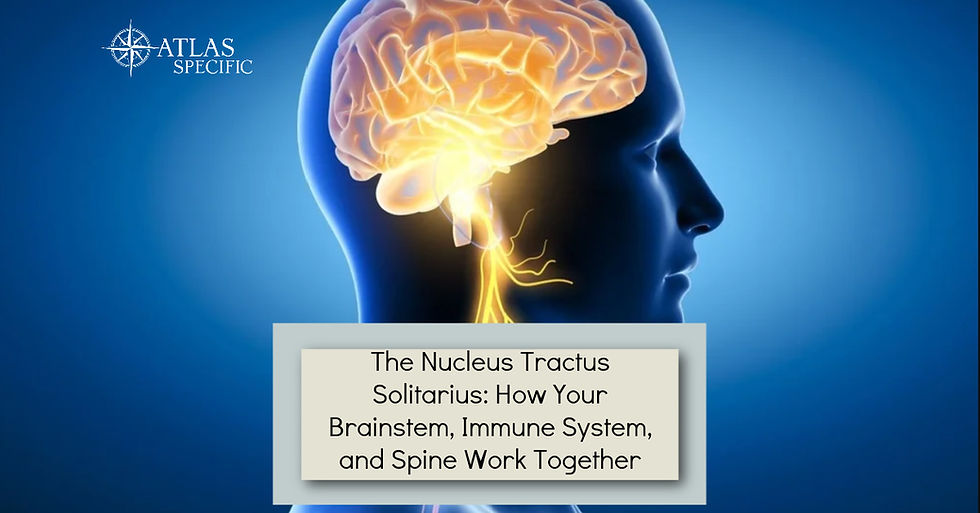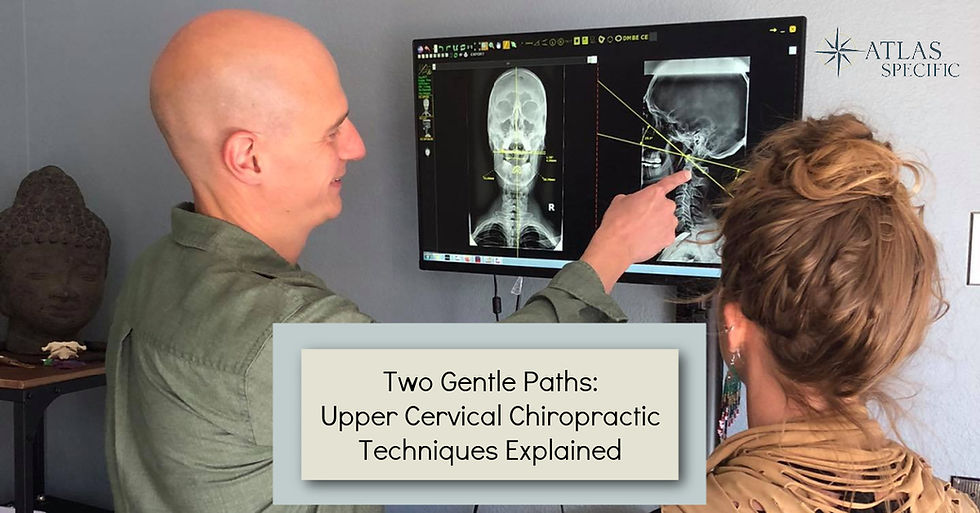The Treatment of Whiplash With Upper Cervical Care
- Timothy Dugas
- Jul 13, 2023
- 4 min read
Updated: Apr 10

Oftentimes, when someone mentions a whiplash injury, you immediately think of two things, car accidents and neck pain. And it’s true, during an auto accident, particularly rear-end collisions, the neck’s structure tends to be the most often affected area. But, car accidents aren’t the only thing that can cause whiplash injuries. They can also happen from falling or tripping, or as a result of a sports injury, particularly during contact sports.
In the past, these types of injuries were often dismissed as nothing more than minor soft tissue damage and were thought to heal relatively quickly on their own. It has now been shown that for many people the real damage may not show up for decades after the initial trauma. And what’s more, if left untreated they can cause severe permanent impairments that may not show up for years.
What is Whiplash?
Whiplash (also referred to as a neck strain or sprain) is an injury to your neck that is caused by your neck bending forcibly forward and then backward or vice versa in a whip-like motion. Typically associated with car accidents, it’s important to note that these injuries have been proven to occur at speeds as low as 5 mph with little to no obvious damage to the vehicle.
Whiplash Symptoms
Any time the neck gets injured, it can trigger all sorts of problems and the symptoms of a whiplash injury can vary significantly depending on the severity of the trauma. Without treatment, whiplash symptoms can last for months or even years. Some of the most common symptoms of whiplash include:
Neck pain
Headaches
Dizziness
Speech impediments
Blurred vision
Tinnitus or ringing ears
Fatigue
Difficulty chewing or swallowing
Stiffness or decreased range of motion in the neck
Shooting pain in the shoulders and/or upper back
What are the Long-term Effects of Whiplash?
As many as 75% of patients who experience a serious whiplash injury suffer long-term effects. If whiplash doesn’t get resolved and the bones or ligaments of the neck aren’t in their proper orientation, they could trigger problems until you have the alignment fixed. Some examples of the issues you can potentially struggle with include:
Chronic neck or back pain
Weakness or numbness of the legs and arms
Headaches or migraines
Fibromyalgia
Bulging or ruptured discs
TMJ
Dizziness or vertigo episodes
Ringing in the ears
Premature arthritis
Anxiety or depression
Sleeping problems
Vomiting or nausea
PTSD
What’s more confusing is the fact that the time between the initial injury and the onset of debilitating symptoms is often so long that the patient doesn’t even realize that the two are directly related.
The Upper Cervical Spine and Whiplash
Because of the forces involved in a whiplash injury, the resulting trauma typically causes a vertebral misalignment of the upper cervical spine known as an Atlas Subluxation Complex.
This condition occurs when one or both of the upper cervical vertebrae (top two bones in the upper neck) become misaligned and cause both neurological and musculoskeletal damage.
These subluxations will often go undetected to the untrained eye and are most commonly
detected through a thorough examination by an Upper Cervical Chiropractor.
How Upper Cervical Care Works
How your injury is treated can determine whether you heal properly or risk a life-long disability. Patients who are treated through more traditional channels are frequently prescribed medications and may undergo some physical therapy, but unless the damage to the neck is corrected, all medication can do is mask the symptoms. Upper cervical care offers a drug-free treatment for whiplash and focuses on fixing the root of the problem.
The process begins by assessing the neck for subluxation through the use of an upper cervical x-ray as well as Digital Infrared Paraspinal Thermography. Then, once your upper cervical chiropractor has the information needed, you get customized adjustments to correct your neck bones’ alignment. Upper cervical chiropractic care is not as intensive as traditional chiropractic methods, so you don’t need to worry about any pulling and twisting of the neck or spine during your treatment. The procedure itself is gentle, allowing your body to heal independently.
Don’t Wait to Get Help for Whiplash
If you or someone you know has experienced a whiplash injury, schedule an appointment with us today by calling, us at 970.259.6803, visiting our Durango office at 1800 E 3rd Ave #108, or clicking the link below. As your only Durango chiropractor specializing in Upper Cervical Care, we can assess any misalignments to your upper cervical spine and get them corrected before they lead to long-term health problems. At Atlas Specific, we provide gentle, drug-free, non-invasive whiplash treatment for patients in the Durango and Four Corners region. We look forward to helping you heal.
Notice of Disclaimer:
We are doctors of upper cervical chiropractic, but we are NOT necessarily YOUR doctors. All content and information on this website is for informational and educational purposes only, does not constitute medical advice, and reading or interacting with this site does not establish any form of patient-doctor relationship. Although we strive to provide accurate information, the information presented here is not intended as a substitute for any kind of professional advice and you should not rely solely on this information. Always consult a professional in your particular area of need before making medical decisions.





Comments